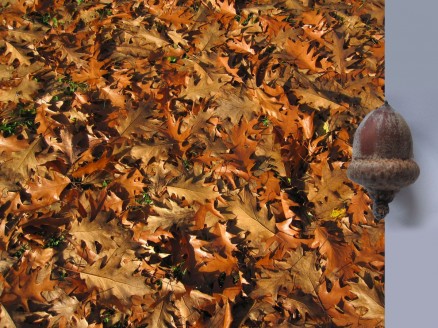By special request from a South African lady, I decided to chose a leaf and the fruits of an oak tree for November.
 There are many different oak trees growing near our home. So, I went out to look and note the differences, always with the thought of transforming the shapes for whitework embroidery. A leaf with few sharp points would be good; I settled on the following shapes:
There are many different oak trees growing near our home. So, I went out to look and note the differences, always with the thought of transforming the shapes for whitework embroidery. A leaf with few sharp points would be good; I settled on the following shapes:

Originally the leaf shape measures approx.10 cm in the width and 7 cm in the height.
Originally the acorn shape measures approx. 2.4 cm in the width and 4.5 cm in the height.
First, the line drawing has to be transferred onto paper using an iron transfer pencil.

 The shapes need a Blanket stitch edge for securing the fabric from fraying.
The shapes need a Blanket stitch edge for securing the fabric from fraying.
So, on Weddigen linen, 13.5/cm thread count, Coral Knot stitches are worked along the inside line using Coton à broder No. 20.
Using Coton à broder No. 20 for both, Chain stitches are worked a small distance outside the Coral Knot stitches. The Chain stitches are covered with densely worked Blanket stitches.
 To get a small stem on the leaf, Blanket stitches are worked down one side and then up the other side. The Blanket stitches on the return pass are placed between the already worked Blanket stitches on the opposite side of the stem.
To get a small stem on the leaf, Blanket stitches are worked down one side and then up the other side. The Blanket stitches on the return pass are placed between the already worked Blanket stitches on the opposite side of the stem.

 Using Coton à broder No. 30 Chain stitches are worked directly inside the Coral Knot stitches.
Using Coton à broder No. 30 Chain stitches are worked directly inside the Coral Knot stitches.

 The acorn cap was filled with Wave stitches (Basic Priciples of Schwalm Whitework, pages 34-36). At first I wanted to fill the acorn seed with padded Satin stitches, but the stitches would become too long. So I decided to take a pattern used in early Schwalm Whitework – close, 2-thread weaving (Early Schwalm Whitework, page 19).
The acorn cap was filled with Wave stitches (Basic Priciples of Schwalm Whitework, pages 34-36). At first I wanted to fill the acorn seed with padded Satin stitches, but the stitches would become too long. So I decided to take a pattern used in early Schwalm Whitework – close, 2-thread weaving (Early Schwalm Whitework, page 19).
 The leaf shape was filled with the openwork filling pattern Cable stitch grid (Basic Principles of Schwalm Whitework, pages 54-56, or Openwork Pattern Samplers, pages 58-61).
The leaf shape was filled with the openwork filling pattern Cable stitch grid (Basic Principles of Schwalm Whitework, pages 54-56, or Openwork Pattern Samplers, pages 58-61).
Please note that this grid was established by cutting only 1 thread and leaving 2, to keep the pattern compact.
 This pattern is especially suitable because all small curves and corners can be covered well.
This pattern is especially suitable because all small curves and corners can be covered well.
 In the end I embroidered some of the leaf veins using Chain stitches.
In the end I embroidered some of the leaf veins using Chain stitches.
After finishing, the embroidered pieces were washed (boiled), starched and ironed. Then, the leaf and the acorn were cut. If needed, such closely trimmed embroidery can be washed and ironed – quickly and easily – at any time, but never spun in a washing machine!
 Some single acorns are easily and quickly embroidered … and now you have one more nice decoration!
Some single acorns are easily and quickly embroidered … and now you have one more nice decoration!




Und wieder eine sehr schöne Idee! Danke!
Alles sehr schön gezeigt. Vielen Dank dafür.